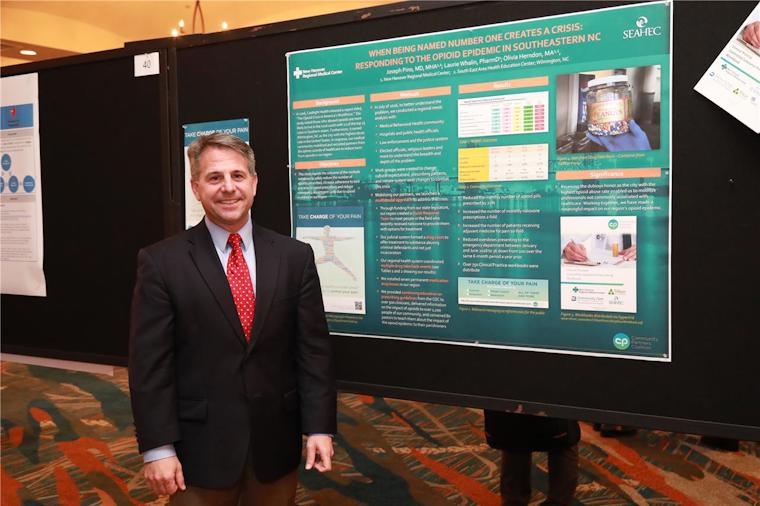In 2016, a Castlight Health report named Wilmington, North Carolina, the city with the highest abuse opioid abuse rate in the US. In response, Joseph Pino, MD, MHA, and members of the community sought to safely reduce the number of opioids prescribed, increase adherence to best practices in opioid prescribing, and reduce emergency department visits due to opioid overdose.
Pino’s poster, When Being Named Number One Creates a Crisis: Responding to the Opioid Epidemic in Southeastern North Carolina, reports the outcome of these multiple initiatives. Dr. Pino took some time to elaborate on the community initiative, which banded together diverse sectors of the community to solve a common problem.
Primary Author: Joseph Pino, MD, MHA
Co-Authors: Laurie Whalin, PharmD, New Hanover Regional Medical Center; Olivia Herndon, MA, New Hanover Regional Medical Center and South East Area Health Education Center
ACGME: Tell us about your academic and professional role.
Pino: I serve as the vice president of graduate medical education and DIO for the New Hanover Regional Medical Center for our four residency programs in internal medicine, family medicine, obstetrics and gynecology, and general surgery. In addition, I serve as the campus director for our University of North Carolina [UNC] School of Medicine Wilmington Campus and executive director of South East Area Health Education Center. This is a role that combines undergraduate, graduate, and continuing medical education. As an internal medicine-pediatrics physician, I also precept in the internal medicine clinic, and take an occasional pediatric hospitalist weekend night call from time to time to stay connected with clinical medicine.
ACGME: Can you briefly describe your project for us?
Pino: Our group organized our health care community and leaders outside of health care—first responders, elected officials, public transit officials, churches and more—to create four work groups to address opioid misuse in our region. These groups included: Primary Prevention; Professional Intervention; Treatment and Recovery; and Infrastructure and Support. Each group developed tactics and executed them. We held each other accountable with regular meetings through our Community Partners Coalition expecting updates from work group leaders. Through this poster, we present the results of the regional effort to reduce harm from opioids in southeastern North Carolina.
ACGME: What inspired you to do this project?
Pino: After learning our city was named number one for opioid misuse by Castlight Health, our regional health department directors, the dean of the College of Health and Human Services at the UNC at Wilmington, and I went through the stages of grief together and decided to do something about it. Determined to take a different approach, we used the collective impact model to successfully mobilize our community to action and do more than any one of us or any one of our organizations could do individually. It was truly remarkable.
ACGME: What did you discover?
Pino: Our community needed a bridge. People and organizations were doing great work that no one knew about. Having a person or agency to bridge all sectors enabled us to make a difference.
We also learned that this is not about opioids. The system that is failing is the system we created. Opioids are what brought people to the table, but it’s not just about opioids. In fact, it was more about the conditions around why individuals use them like the social determinants of health. If we don’t address these issues from all angles, change will not be sustained.
Finally, we learned that we needed to destigmatize addiction in our community.
ACGME: What was the greatest challenge in pulling together so many different partners?
Pino: Coordinating communication and maintaining momentum can sometimes be a challenge. We addressed this through quarterly coalition meetings and regular subgroup meetings led by influential community leaders.
ACGME: What was the main takeaway?
With problems like opioid misuse, the issue extends beyond health care and needs a bigger solution involving multiple stakeholders. Leveraging our relationships with others across the region, we were able to have a measurable impact.
ACGME: What advice do you have for communities that may be interested in creating a similar consortium of partners and initiatives?
Start small and identify key partners and influential leaders. Mobilizing them allowed us to gain momentum and expand our reach.
ACGME: Are there plans for continuing or expanding these initiatives into the future?
We are currently exploring the opportunity to expand the work in this area and focus on another regional issue that is not catching a lot of attention. The area of focus is being narrowed down and we hope to move forward on the next initiative soon.

